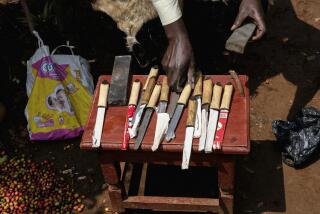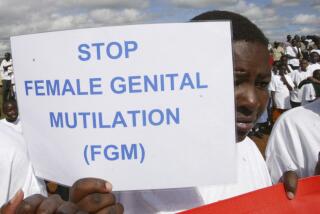Long-Awaited Circumcision Rites May be Last for Remote Kenya Tribe : Africa: Spread-out cycle coming to an end as two generations face dramatic changes in social behavior.
- Share via
LESIRIKAN, Kenya — They came over the ridge behind the village about 8 in the morning, when the air was still cold and the sun was just rising over the Ndoto mountains.
Their singing could be heard long before they were visible, their deep male voices ringing out over the great dry plain.
They were coming from the south, dark figures on the top of the hill, 30 or 40 of them in a surging line, moving rapidly through the dust and the dried grass.
They wore only black. Flapping kilts or cloaks or loin cloths of black on their black skin, creating a procession of magicians, cut-out shadows against the tawny, brightening bush.
“It is the color of God,” said Rita Lekisat. And for weeks now nurses like Lekisat, working for a development project called Samburu Aid in Africa, will have little time for the naturally sick. Infected circumcism cuts will be the order of the day. And there will be hundreds.
They cut downhill, ignored the 10 or so houses of Lesirikan--an incidental landmark--and passed northward with that easy haste toward the blue outline of Lolegnok mountain.
They were all boys or young men, most in their mid-teens. They had walked miles to be circumcised.
Hundreds of African tribes practice circumcision--male and female--every year or every other year as an initiation rite for marriage or adulthood.
The Samburu of Kenya circumcise their boys in the 80,000-strong tribe only once every 14 or 15 years. It is a religious and social event almost without parallel in other cultures.
This year’s circumcision is more special than most. For, as change and the 21st Century come to this extraordinary outback in northern Kenya, there are local fears that the 1990 ceremony, the first since 1976, may be the last to be performed on an epic scale.
But if any culture can resist change, it is the Samburu. Their land, somewhere in limbo between the game parks of the south and Lake Turkana in the north, is not a place where Kenya’s tourists come. It is not even a place where non-Samburu Kenyans come if they can help it. The land and the people are strange to them.
The village of Lesirikan lies in one of the most remote parts of this remote land. Up here there are precisely two geographical features that might pass themselves off as roads, but there is not a drop of gasoline for sale for almost 100 miles in any direction.
There is precious little water; no one bothers much with growing things. There is no power, except north on the main road, and most people have never seen a telephone.
They keep goats, cows and sometimes camels. They move across the country as the mood takes them. “Government” is a vaguely understood term. Taxation is a myth. The name of President Daniel Arap Moi is unfamiliar. Life is very slow and very good and the Samburu do what the Samburu do.
These are the El Barta plains, only 220 miles north of Nairobi’s skyscrapers. It might as well be a thousand.
This is more like some idealized Wild West than the tropics. The sky is a curved-blue hollow, the wind a warm breath. There are occasional thorn trees. There is burnt grass and an unthinkable amount of space. At evening, the whole land turns red. The view runs for miles, away to Mt. Ngiro, the flat-topped, enormous traditional home of God, whom the Samburu call Nkai.
It is a place that encourages walking, especially now in the dry season when the riverbeds are hot, stony valleys and the legs swing easy in the breeze.
The Samburu think nothing of a week’s walk. These boys have come from Archer’s Post, a settlement 90 miles to the south, and will begin their walk back tomorrow or the next day.
Their destination, Lolegnok mountain, looks unimaginably far, but they will be there this afternoon or tonight. They have come to collect gum from a plant that grows on its slopes. Every circumcision candidate must do this.
The gum goes on the tips of arrowheads in a blunt ball. When it has hardened, the arrows will be used to kill birds without piercing them. The unbloodied feathers will adorn the boys after the ceremony, when they paint their heads and upper chests red, wear red cloth and bead necklaces of blue, green, yellow and red.
They will have become Moran.
The Samburu practice a social system of age-sets that is almost unique in modern anthropology.
All Samburu men belong to one of three age-sets--boys, Moran or elders. Their actual physical age is far less important than their set.
At each circumcision, those who were previously Moran become elders, those who were boys pass into Moranhood. The Moran can be anywhere from 14 to about 27 years old when initiated, because the circumcision rite is practiced--with occasional exceptions--only when the elders decide enough years have elapsed.
A Morani is the traditional warrior protector of the nomadic Samburu. In his first years of Moranhood he is forbidden from eating in a Samburu settlement and must forage in the bush, rather like the young Australian aborigines who “walkabout” for a year after initiation.
The Moran live together in groups for most of their time in the age-set, marrying only in the last years of Moranhood before becoming elders. This, in part, permits the elders to practice traditional Samburu polygamy by keeping the Moran out of the market for wives until they are almost 30. It also vests political power exclusively in the hands of the elders.
Circumcisions, performed by those who have learned the craft from their fathers, are carried out on large groups of aspirants, sometimes a hundred at a time.
In northern Samburu, “circumcision” is a misnomer. The surgeon cuts his way only about 355 degrees around the foreskin and then ties what he has cut into a sort of adolescent equivalent of the umbilical knot, a permanent, dangling reminder of initiation.
Obviously, it hurts. It is a bloody operation.
For weeks now, nurses like Rita Lekisat, working for a development project called Samburu Aid in Africa, will have little time for the sick. Infected circumcision cuts will be the order of the day, and there will be hundreds. The gore and the pain is only distressing to Western eyes.
In this clear air, with the Earth so alive and the world so simple, what comes across strongest is a sense of vast tradition and hugely powerful social and religious meaning.
Thousands of people have moved their families, their livestock and their homes across the country to places of mass circumcision. Little towns of wattle huts have sprung up in strange places on the landscape’s skin.
Thousands of boys have made the pilgrimage to Lolegnok. Thousands of goats will be slaughtered and roasted during the three months that the circumcisions last. The whole of society is about to shift around one notch. Two generations will, overnight, alter their social behavior.
And it may be for the last time.
Children are going to school. Female circumcision, illegal in Kenya for years but still practiced as a pre-wedding ceremony here, is dying out.
In the last few years, more families have held small, almost-private male circumcisions outside the proper cycle.
A spear-bearing warrior class is a strange thing for 1990, and for the most part the Samburu live in peace with their old cattle-raiding foes, the Turkana to the north.
The clothes are changing: “Guinness is good for you,” proclaims the T-shirt of the old man scooping water from a hand-dug riverbed well. His friend wears reflecting dark glasses and a pork-pie hat.
There is medicine. There is cement. There are even alternatives to walking.
In the middle of this vastness, with the blue evening coming on, a Morani, looking traditional, flags down the Landrover and asks for a lift for himself and his three goats.
“It may be the last big one,” said Gabriel Lochgan, Samburu Aid project coordinator, of tomorrow’s circumcision. “People no longer think the same way. Things are changing.
“I was born just over there,” he said, nodding into the unchanging darkening plain. “It will be slow, maybe. And it isn’t bad. It is only change.”
More to Read
Sign up for Essential California
The most important California stories and recommendations in your inbox every morning.
You may occasionally receive promotional content from the Los Angeles Times.












